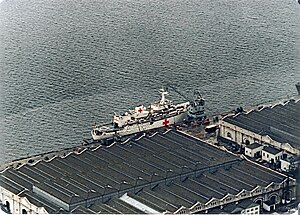 Hecla at HM Naval Base Gibraltar, during conversion to a hospital ship for use during the Falklands War
| |
| History | |
|---|---|
| Name | HMS Hecla |
| Builder | Blythswood |
| Laid down | 6 May 1964 |
| Launched | 21 December 1964 |
| Completed | 24 August 1965 |
| Commissioned | 9 September 1965 |
| Identification |
|
| Fate | Sold 1997 |
| General characteristics | |
| Class and type | Hecla-class survey vessel |
| Displacement | 2,800 tons full load |
| Length | 79 m (259 ft 2 in) |
| Beam | 15.4 m (50 ft 6 in) |
| Draught | 4.9 m (16 ft 1 in) |
| Propulsion | 3 × Paxman Ventura V-12 diesel engines |
| Speed | 14 knots (26 km/h; 16 mph) maximum |
| Range | 12,000 nmi (22,000 km; 14,000 mi) at 11 knots (20 km/h) |
| Complement | 121 |
| Aircraft carried | 1 × Westland Wasp light helicopter |
HMS Hecla was the lead ship of the Hecla class, an oceangoing survey ship type in the Royal Navy. She was ordered in the mid-1960s, along with her sister ships HMS Hecate and HMS Hydra. A fourth ship, HMS Herald, was completed in the early 1970s. The ship served for thirty years in this role, and various others, before finally being replaced by HMS Scott in 1997. Hecla was sold to private interests, being renamed "Bligh" after Vice-Admiral William Bligh. After this, the vessel was used in a hydrographic survey of Irish waters, and was based in Waterford, Ireland.